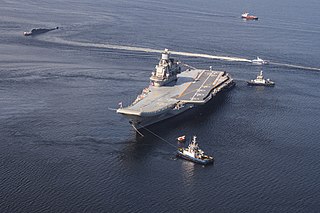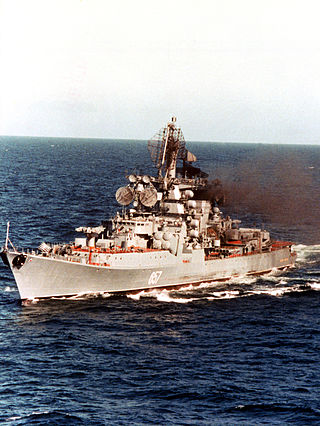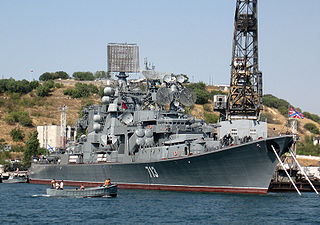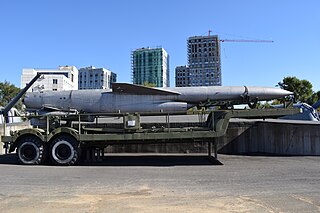
A cruiser is a type of warship. Modern cruisers are generally the largest ships in a fleet after aircraft carriers and amphibious assault ships, and can usually perform several operational roles from search-and-destroy to ocean escort to sea denial.

The Kuznetsov-class aircraft carrying cruiser, Soviet designation Project 1143.5, is a class of STOBAR aircraft carriers operated by the Russian and Chinese navies. Originally designed for the Soviet Navy, the Kuznetsov-class ships use a ski-jump to launch high-performance jet aircraft and arrestor gears for landing. The design represented a major advance in Soviet fleet aviation over the Kiev-class carriers, which do not have full-length flight deck and could only launch VSTOL aircraft. The Soviet Union's classification for the class was as a heavy aircraft-carrying cruiser, which permits the ships to transit the Turkish Straits without violating the Montreux Convention. However, the Chinese variants are classified as aircraft carriers.

The Kirov class, Soviet designation Project 1144 Orlan, is a class of nuclear-powered guided-missile battlecruisers of the Soviet Navy and Russian Navy, the largest and heaviest surface combatant warships in operation in the world. Among modern warships, they are second in size only to large aircraft carriers, and of similar size to a World War I-era battleship. The ships are often referred to as battlecruisers by Western defence commentators due to their size and general appearance. The Soviet classification of the ship-type is "heavy nuclear-powered guided-missile cruiser".

The Soviet Navy was the naval warfare uniform service branch of the Soviet Armed Forces. Often referred to as the Red Fleet, the Soviet Navy made up a large part of the Soviet Union's strategic planning in the event of a conflict with the opposing superpower, the United States, during the Cold War (1945–1991). The Soviet Navy played a large role during the Cold War, either confronting the North Atlantic Treaty Organization in western Europe or power projection to maintain its sphere of influence in eastern Europe.

Kirov is the lead ship of the Kirov class of nuclear-powered guided missile cruisers. Originally built for the Soviet Navy and passed onto the succeeding Russian Navy, she and her three sister ships are the largest and heaviest surface combatant warships built by them. The Soviet classification of the ship-type is "heavy nuclear-powered guided missile cruiser", nonetheless Kirov's size and weapons complement have earned her the unofficial designation of a battlecruiser throughout much of the world, as her size and displacement is similar to a typical World War I battleship. The appearance of the Kirov class was a significant factor in the U.S. Navy recommissioning the Iowa class. She was named after a Project 26 cruiser.

The Ukrainian Navy is the maritime forces of Ukraine and one of the five branches of the Armed Forces of Ukraine.

The Kiev class, Soviet designation Project 1143 Krechyet (gyrfalcon), was the first class of fixed-wing aircraft carriers built in the Soviet Union for the Soviet Navy.

The Kresta I class, Soviet designation Project 1134 Berkut, was a class of guided missile cruiser built in the Soviet Union for the Soviet Navy. The ships were designed for a surface warfare role, but Soviet priorities were changed to an anti-submarine role and only four ships were built in this configuration. They were followed by the Kresta II class, an anti-submarine warfare variant.

The Slava class, Soviet designation Project 1164 Atlant, is a class of guided-missile cruisers designed and constructed in the Soviet Union for the Soviet Navy, and currently operated by the Russian Navy.

The Kresta II class, Soviet designation Project 1134A Berkut A, was a class of guided missile cruiser built by the Soviet Union for the Soviet Navy. The NATO lists the class as "cruisers" mainly due to the Metel anti-ship missile system capable to strike not only submarines but also surface vessels.

The Kara class, Soviet designation Project 1134B Berkut B, was a class of guided missile cruisers built in the Soviet Union for the Soviet Navy. The NATO lists the class as "cruisers" mainly due to the Metel anti-ship missile system capable of striking not only submarines, but also surface vessels.

The P-500 Bazalt is a turbojet-powered, supersonic cruise missile used by the Soviet and Russian navies. Its GRAU designation is 4K80 and its NATO reporting name is SS-N-12 Sandbox, its upgraded version being the P-1000 Vulkan AShM SLCM.

The Project 58 missile cruisers, known to NATO as the Kynda class and sometimes referred to as the Grozny class, from the name of the first ship of the series to be constructed, were the first generation of Soviet missile cruisers and represented a considerable advance for the Soviet Navy. Their main role was anti-surface warfare using the SS-N-3b 'Shaddock' missile. The design proved to be top-heavy and was soon succeeded by the larger Kresta I class, but the Kyndas stayed in service until the fall of the Soviet Union.

The Sverdlov-class cruisers, Soviet designation Project 68bis, were the last conventional gun cruisers built for the Soviet Navy. They were built in the 1950s and were based on Soviet, German, and Italian designs and concepts developed before the Second World War. They were modified to improve their sea capabilities, allowing them to operate at high speeds in the rough waters of the North Atlantic. The design carried an extensive suite of modern radar equipment and anti-aircraft artillery. The Soviets originally planned to build 40 ships in the class, to be supported by the Stalingrad-class battlecruisers and various aircraft carriers.

Moskva, formerly Slava, was a guided missile cruiser of the Russian Navy. Commissioned in 1983, she was the lead ship of the Project 1164 Atlant class, named after the city of Moscow. With a crew of 510, Moskva was the flagship of the Black Sea Fleet and the most powerful warship in the region.

Pamiat Azova was a unique armoured cruiser built for the Imperial Russian Navy in the late 1880s. She was decommissioned from front line service in 1909, converted into a depot ship and sunk by British torpedo boats during the Baltic Naval War, part of the Russian Civil War.

Novorossiysk was a conventionally powered aircraft carrier that served the Soviet Navy and the Russian Navy from 1982 to 1993. She was the third Kiev-class vessel to be built. She was designed to engage in offensive actions as a guided missile cruiser mostly using her deck mounted missiles as well as support anti-submarine and surface actions with her embarked air group.
Azov is a town in Rostov Oblast, Russia.
Kerch is a city in Crimea in Eastern Europe.
















